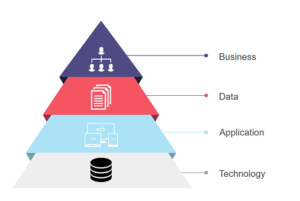Does Your Business Suffer of..
Expensive IT Applications + Manual procedures still exists + Staff working with their own concepts = Sleazy / Disjoined Operational Environment
What is Enterprise Architecture (EA)?
Enterprise Architecture collects the functionality of the enterprise “computerized applications” and the still existing “manual procedures for the different Independent Entities combines it with professional “staff assessments” to generate a unique business process for the owner, all audited and controlled by a fair independent indirect auditing hidden mechanism.
Why EA?
Enterprise Architecture aims to create a standard unique business process at one or more levels (strategic, administrative, finance or operations) of the enterprise in an integrated unique mode.
Ultimately, KPIs can be generated and presented on a DASHBOARD using the current available system resources.
EA Fact Sheet
Flexible enterprise architecture provides a consistent framework for strategic decisions about the information technology / manual procedures and staff skills that used to support business initiatives.
Enterprise Architecture is mainly dedicated to the FAMILY BUSINESSES and to the self made owners who face problems in controlling their widespread business(es)
Enterprise architecture is just a mean for the business intergeneration transition using safely inspiring / standard / international / and approved methodology
EA Implementation
The Baseline Architecture documents the existing systems. (“System” refers to all aspects of the enterprise, including employees, manual and computerized business processes).
The Target Architecture is the formal documentation of the desired future vision – defining and validating future requirements and the optimization of opportunities.
The Transition Plan documents how to change from the Baseline to the Target
| First Phase | Baseline Architecture (the “Current”) |
| Second Phase |
Target Architecture (the “To Be”) Transition Plan |
EA Transition Strategy
EA relies on an implicit separation between “Ownership”, “Audit and Control” and “Operation Environment”. To fulfill the governance concept, EA Principles establish the basis for a set of rules and behaviors for organization governance

